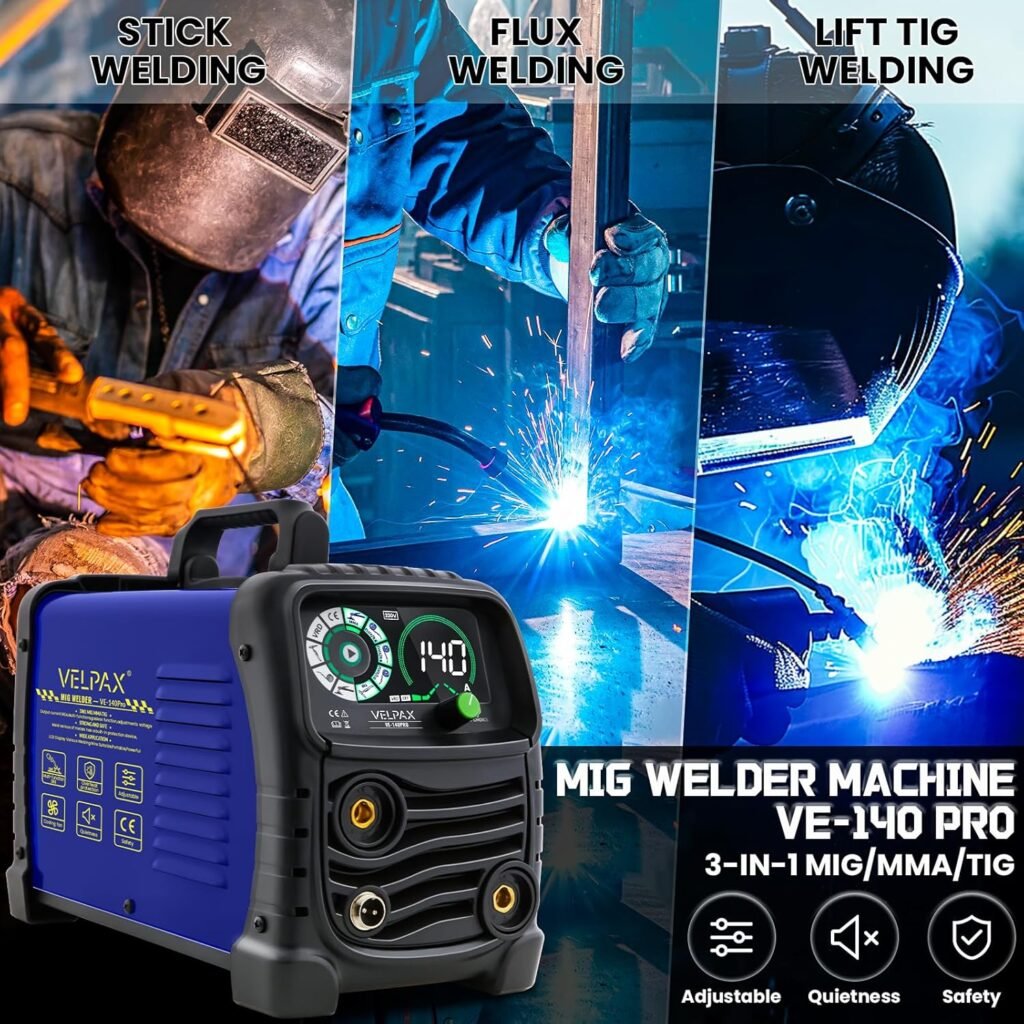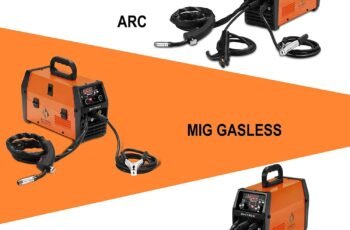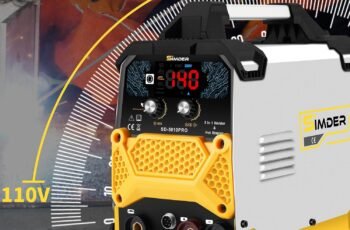Ad Blocker Detected
Our website is made possible by displaying online advertisements to our visitors. Please consider supporting us by disabling your ad blocker.
Looking for a compact, gasless 3-in-1 welder that you can use at home, in a small workshop, or outdoors with minimal fuss?
Product overview
You’re looking at the 140A 230V MIG Welder Gasless, 3 in 1 Welding Machine Flux Core Welder, Portable Welder with IGBT Inverter, Smart Digital LED Dispaly and Welding Rods Flux Wires as a multi-purpose tool that promises MIG, MMA (stick), and TIG capability in a single unit. The machine emphasizes gasless flux-cored MIG welding, an IGBT inverter for efficient power conversion, and a Synergy control system to simplify setup and improve weld consistency.
What this machine is designed to do
This unit is designed to give you a versatile, beginner-friendly welder that minimizes the setup complexity of traditional gas MIG systems. You’ll appreciate that it’s aimed at higher efficiency welding with one-time formation and reduced need for finishing work like knocking and grinding.
What’s typically included
You’ll usually receive the main welding unit, a ground clamp, a MIG torch or gun, a stick electrode holder, flux-cored wires and welding rods (as advertised), and a power cable. Manuals and a few spare consumables may also be included, but exact accessory lists vary by seller, so you should confirm contents before buying.
Key specifications (at-a-glance)
Below is a quick table to help you compare the core specs at a glance and know what to expect from the machine.
| Feature | Specification / Value | Notes |
|---|---|---|
| Model name | 140A 230V MIG Welder Gasless, 3 in 1 Welding Machine Flux Core Welder, Portable Welder with IGBT Inverter, Smart Digital LED Dispaly and Welding Rods Flux Wires | Full product name for reference |
| Input voltage | 230V | Single-phase household voltage in many regions |
| Maximum welding current | 140A | Peak welding current rating advertised |
| Welding modes | MIG / MMA (stick) / TIG | 3-in-1 functionality; check TIG capabilities for gas requirement |
| Wire sizes supported | 0.8 / 0.9 / 1.0 mm flux-cored wire | Gasless welding via flux-cored wire |
| Control system | Synergy intelligent control with built-in Synergy Chip | Auto-regulates current and arc start |
| Display | Smart Digital LED display | Shows current, parameters, and settings |
| Inverter type | IGBT inverter | Efficient, lighter, and more compact than transformer units |
| Protections | Overheat and overcurrent protection | Auto-shutoff and restart after cooldown |
| Noise | Switching frequency above audio range | Less audible switching noise |
| Portability | Lightweight/portable design | Great for home or outdoor use |
| Typical applications | Home, light fabrication, outdoor work | Ideal for learners and hobbyists |
Performance and weld quality
You’ll notice the Synergy control aims to make welding performance more consistent by automatically regulating parameters based on the wire and thickness you select. That automation reduces guesswork and often improves arc stability, which makes it easier to get clean beads without excessive spatter.
The flux-cored MIG mode is optimized for gasless operation, so you’ll benefit outdoors or in environments where shielding gas is impractical. The unit claims “one time moulding without knocking and grinding,” which means with the right settings you should get smoother welds that need less finishing — though your technique and material prep still matter.
Synergy control and the built-in chip
You’ll appreciate that the Synergy intelligent control automatically matches welding current to the selected settings. This system is particularly helpful if you’re still learning how to balance wire feed, voltage, and travel speed. The built-in chip helps the arc start cleanly and adjusts behavior to avoid common defects like burn-through or lack of fusion on thin metals.
Synergy systems don’t remove all skill requirements, but they narrow the tuning window and can save you time when switching between job types.
Arc stability and bead appearance
Expect stable arcs at proper settings, and the flux-cored wire should give you good penetrative welds on mild steel. The absence of shielding gas can increase spatter compared with MIG with gas, but you’ll avoid drafts that cause porosity when working outdoors. With correct technique and parameter setup, your bead appearance should be tidy enough to minimize grinding or cosmetic finishing.
Welding modes: MIG, MMA (stick), TIG
You’ll have three modes to choose from, which makes the unit flexible across many tasks.
- MIG (flux-cored, gasless): Best for quick, outdoor, or convenience-focused welding on carbon steel. You won’t need external shielding gas when using flux-cored wire.
- MMA (stick): Handy for working with dirty, rusty, or painted materials where stick electrodes are advantageous. This mode is also useful in windy conditions.
- TIG: The TIG function on multi-mode units like this can vary. It may support basic TIG tasks (often lift-start) but may not fully replace a dedicated TIG machine. If you expect to TIG-weld stainless or aluminum for precision work, you should confirm whether the TIG function requires shielding gas and what level of control (AC or DC, HF start or lift start) it offers.
You’ll want to check the seller’s full spec sheet if TIG is a priority for precision stainless or aluminum welding jobs.
Wire feed and flux-cored operation
Flux-cored wire sizes supported (0.8/0.9/1.0 mm) match common spool sizes, which makes sourcing consumables straightforward. You’ll benefit from a consistent wire feed speed that the machine advertises, and the Synergy system will help match wire feed to current for predictable arcs.
Flux-cored wire is forgiving for outdoor or draughty environments and often delivers deeper penetration than gas-shielded MIG at similar currents. You’ll have to chip away the slag produced by flux-cored welds, but properly executed welds will have good mechanical strength and appearance.
Advantages and limitations of flux-cored wire
Flux-cored is great for outdoor, windy, or unprepared surfaces. You’ll save on shielding gas costs and setup complexity. The limitations include more spatter, necessity to remove slag, and potential reduced lift in cosmetic appearance compared to gas MIG. You should also avoid flux-cored wire for thin, delicate sheet metal unless you can dial current way down and practice precise control.
Digital LED display and controls
You’ll find a smart digital LED display that shows welding current and adjustable parameters clearly, making setup faster and less guess-based. The large, user-friendly interface is useful for toggling between modes and for setting wire diameter, workpiece thickness, and arc characteristics.
Since the display is digital, you can react quickly to material or electrode changes and keep a record of what settings worked for which tasks in your head or notes.
One-key switch and user experience
The one-key switch simplifies switching between the three welding modes, reducing time you spend in menus. If you’re a beginner or switching between jobs frequently, this single-switch approach is convenient and reduces the chance of misconfiguration.
You should still familiarize yourself with manual adjustments for wire speed, current, and so on — automatic modes are a great starting point but sometimes require manual fine-tuning.
Safety features and protections
You’ll benefit from integrated overheating and overcurrent protection that will halt operation if internal temperatures or currents exceed safe limits. This allows the machine to cool and automatically resume when safe, protecting both internal electronics and your workpiece.
Other safety considerations include good ventilation and periodic cleaning to prevent dust or slag buildup. Even with protections, you should wear appropriate PPE (helmet, gloves, jacket) and follow safe electrical hookup practices.
Thermal management and reliability
The IGBT inverter generates efficient power conversion but still needs airflow for cooling. You’ll want to keep the vents clear and avoid prolonged work cycles that push the unit into its thermal cutout frequently, since excessive thermal cycling can shorten component life. Letting the unit rest when it overheats is normal and safer.
Portability and build quality
You’ll notice the unit is described as lightweight and portable, making it suitable for transport to job sites or for carrying around a home garage. The compact IGBT inverter design contributes to a smaller footprint than old-school transformer welders.
While the product description emphasizes portability, you should evaluate the casing, handle, and accessory fitment in person if possible. A comfortable handle and secure accessory storage make a big difference in daily usability.
Typical applications and material compatibility
This machine is positioned as a great choice for home use, hobbyists, small repairs, automotive touch-ups, and outdoor work. You’ll find it well-suited to mild steel and carbon steel; stainless steel can be welded with appropriate flux-cored wires or electrodes, but you may need post-weld clean-up.
Aluminum welding with this machine is limited unless you pair with a proper spool gun and AC capability — most gasless flux-cored systems are not ideal for aluminum since aluminum requires special feeding and usually gas shielding.
Suggested material thickness range
At 140A peak, you’ll typically weld thin to medium thickness steel effectively. For clean welds and good penetration, you can generally expect good results up to several millimeters thick (e.g., commonly up to about 4–6 mm on mild steel) depending on joint type and technique. For thicker plates, you may need multiple passes or a higher-amperage machine.
Accessories and consumables
You’ll need an assortment of consumables to keep welding: flux-cored wire in the correct diameter, contact tips, nozzles, and replacement parts like rollers. Basic accessories you should have include a welding helmet or auto-darkening mask, welding jacket or gloves, chipping hammer, wire brush, and a grinder for finishing.
The machine often comes with basic rods and wires, but you’ll want to stock spares and higher-quality consumables if you expect heavier use.
Pros and cons — what you’ll like and what to watch for
You’ll find clear advantages in affordability, portability, and simplicity, but there are trade-offs and limitations.
Pros:
- You’ll enjoy the convenience of gasless MIG for outdoor work and quick setup.
- The Synergy control reduces the learning curve and speeds up parameter selection.
- Digital LED display makes adjustments clear and repeatable.
- IGBT inverter design keeps the unit compact and energy efficient.
- Overheat and overcurrent protection improve safety and reliability.
Cons:
- You’ll get slag with flux-cored welds and will need to chip and clean beads.
- TIG functionality might be basic compared to dedicated TIG machines — verify TIG capabilities if that’s critical.
- Flux-cored welding can produce more spatter than gas-shielded MIG, which may increase cleanup.
- Aluminum welding is likely limited or impractical without special equipment.
Setup and first-time use guide
When you first use the machine you’ll want to validate wiring, earth connection, and consumable installation before striking an arc.
- Confirm the machine is connected to a proper 230V supply and check the cable and plug condition. You’ll want a dedicated circuit for extended welding.
- Install the appropriate spool of flux-cored wire (0.8/0.9/1.0 mm), ensure correct orientation, and set proper wire tension. Too much tension will stretch the wire; too little causes slip.
- Set polarity based on wire or electrode requirements (usually DC+ or DC- depending on the welding mode and consumable).
- Start with moderate settings on the SYNERGY recommended ranges and make test beads on scrap material to dial in wire speed and current.
- Check ground clamp placement on clean, bare metal for the best return path.
You’ll want to practice on scrap pieces to get a feel for travel speed and arc length. The Synergy control gives you a solid starting point — but your technique will still matter for consistent joints.
Common troubleshooting and quick fixes
You’ll likely encounter a few common issues as you get started; these quick fixes should help:
- Wire feeding inconsistently: Check spool orientation, tensioner setting, and drive roller type. Replace worn rollers or set correct groove for wire diameter.
- Excessive spatter: Trim arc length, reduce voltage slightly, and check wire feed speed. Use anti-spatter spray around the nozzle.
- Porosity in welds: Ensure clean base metal, proper wire type, and stable travel speed. Although flux-cored is more forgiving outdoors, heavy wind or contaminated metal can still cause porosity.
- Machine cuts out on long runs: This is likely thermal protection activating. Let the unit cool or shorten your duty cycles.
- Poor arc start: Confirm Synergy settings and electrode/wire match. Tighten connections and confirm good ground contact.
Maintenance and care
You’ll extend the machine’s life by performing simple maintenance tasks regularly.
- Keep ventilation slots clear of dust and welding debris; compressed air cleaning works well when the unit is powered off and unplugged.
- Inspect cables, connectors, and the torch for wear. Replace consumables and damaged insulation promptly.
- Clean or replace contact tips and nozzles to ensure good electrical contact and consistent feeding.
- Store the machine in a dry place and protect it from moisture and corrosive fumes.
Routine checks will prevent most performance issues and keep your workflow consistent.
Who this welder is best for
You’ll benefit most if you’re a hobbyist, DIYer, small-shop owner, or learner who values versatility and portability. If you perform occasional outdoor welding, automotive repairs, or small fabrication projects, the gasless flux-cored MIG and MMA modes are especially useful.
If you’re a professional who needs heavy continuous-duty welding, high-precision TIG for exotic metals, or frequent aluminum welding, you may prefer a higher-amperage or specialized machine.
Comparisons and buying considerations
When you’re comparing this machine to other options, consider these points:
- Gasless convenience vs. gas MIG: You’ll save on gas and avoid wind problems with flux-cored wire, but you’ll accept more slag and potential spatter.
- 3-in-1 versatility: You’ll gain flexibility, but note that multifunction units may not match a dedicated TIG machine’s finesse or a high-amperage MIG machine’s throughput.
- IGBT inverter benefits: You’ll get a lighter, more energy-efficient machine with better arc control than old transformer units.
Before you buy, confirm the included accessories, warranty terms, and availability of consumables in your area.
Tips to get the best welds with this unit
You’ll get the best results with some practical adjustments and routine checks:
- Always clean the metal surface where you’ll weld; flux-cored wire tolerates some contamination but less is always better.
- Practice maintaining a consistent travel speed and distance from the arc; consistency beats random higher amperage.
- Use recommended rollers and drive settings for the wire diameter you’re feeding to prevent birdnesting and feeding problems.
- If you’re switching between modes, check polarity and torch connections each time.
- Keep a small stash of different wire diameters and electrode types so you can tailor consumables to your project.
Frequently asked questions (FAQ)
You’ll often ask similar questions; here are clear answers:
- Can you weld outdoors without shielding gas? Yes — flux-cored wire is specifically designed for gasless welding outdoors, which is one of this unit’s main advantages.
- Is the TIG mode capable of professional-grade TIG welding? The TIG function gives you added versatility, but it may not replace a dedicated TIG machine for demanding precision work; verify specifics with the seller if TIG is a priority.
- Can you weld aluminum with this machine? Aluminum generally needs a spool gun and often AC TIG capability; this machine is not optimized for aluminum unless modified or paired with suitable accessories.
- How safe is the welder? The machine includes overheat and overcurrent protection and will shut down if limits are exceeded, but you should still follow standard welding safety practices.
Final recommendation
You’ll find the 140A 230V MIG Welder Gasless, 3 in 1 Welding Machine Flux Core Welder, Portable Welder with IGBT Inverter, Smart Digital LED Dispaly and Welding Rods Flux Wires a compelling choice if you want a portable, user-friendly, and economical multi-mode welder for home and outdoor use. The Synergy control and digital display reduce setup time and make it a strong option for beginners and hobbyists.
If you need heavy-duty continuous welding, precision TIG for exotic metals, or frequent aluminum work, consider whether a dedicated higher-spec machine better fits your needs. Otherwise, this unit offers balanced performance, convenient gasless welding, and helpful safety and control features that will likely serve your projects well.
Disclosure: As an Amazon Associate, I earn from qualifying purchases.







